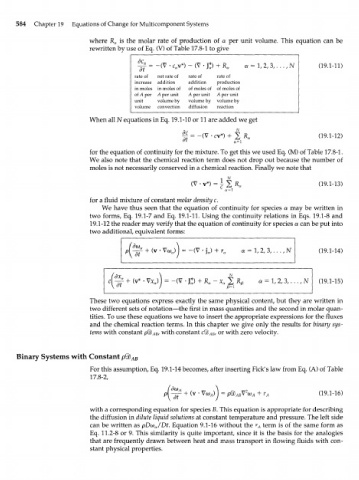Page 604 - Bird R.B. Transport phenomena
P. 604
584 Chapter 19 Equations of Change for Multicomponent Systems
where R Q is the molar rate of production of a per unit volume. This equation can be
rewritten by use of Eq. (V) of Table 17.8-1 to give
дс _
а -(V • c v* >-(v-j;) + K a = ,2,3, . . . , N (19.1-11)
1
dt a a
rate of net rate of rate of rate of
increase addition addition production
in moles in moles of of moles of of moles of
of A per A per unit A per unit A per unit
unit volume by volume by volume by
volume convection diffusion reaction
When all N equations in Eq. 19.1-10 or 11 are added we get
(19.1-12)
for the equation of continuity for the mixture. To get this we used Eq. (M) of Table 17.8-1.
We also note that the chemical reaction term does not drop out because the number of
moles is not necessarily conserved in a chemical reaction. Finally we note that
(V • v*) = £ £ R a (19.1-13)
for a fluid mixture of constant molar density с
We have thus seen that the equation of continuity for species a may be written in
two forms, Eq. 19.1-7 and Eq. 19.1-11. Using the continuity relations in Eqs. 19.1-8 and
19.1-12 the reader may verify that the equation of continuity for species a can be put into
two additional, equivalent forms:
{ dt + ( , 7 ' *o)- -( и a = ..2 ,3,. (19.1-14)
<dx a + (v* • Vx = -(V + R - x N a = 1/ 2, 3,.. (19.1-15)
v л с•') a Q 1 • ,N
/3 = 1
These two equations express exactly the same physical content, but they are written in
two different sets of notation—the first in mass quantities and the second in molar quan-
tities. To use these equations we have to insert the appropriate expressions for the fluxes
and the chemical reaction terms. In this chapter we give only the results for binary sys-
tems with constant рЯЬ with constant сЯЬ , or with zero velocity.
АВ/
АВ
Binary Systems with Constant рЯЬ АВ
For this assumption, Eq. 19.1-14 becomes, after inserting Fick's law from Eq. (A) of Table
17.8-2,
f ( V (19.1-16)
with a corresponding equation for species B. This equation is appropriate for describing
the diffusion in dilute liquid solutions at constant temperature and pressure. The left side
can be written as pDo) /Dt. Equation 9.1-16 without the v A term is of the same form as
a
Eq. 11.2-8 or 9. This similarity is quite important, since it is the basis for the analogies
that are frequently drawn between heat and mass transport in flowing fluids with con-
stant physical properties.

